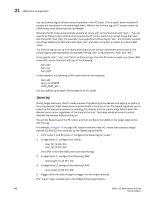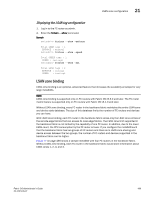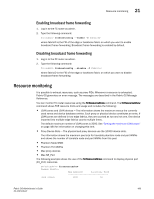HP StorageWorks 1606 Brocade Fabric OS Administrator's Guide v6.3.0 (53-100133 - Page 533
How LSAN zone binding works, FC router matrix definition, automatically propagated from one backbone
 |
View all HP StorageWorks 1606 manuals
Add to My Manuals
Save this manual to your list of manuals |
Page 533 highlights
LSAN zone configuration 21 How LSAN zone binding works LSAN zone binding uses an FC router matrix, which specifies pairs of FC routers in the backbone fabric that can access each other, and an LSAN fabric matrix, which specifies pairs of edge fabrics that can access each other. You set up LSAN zone binding using the fcrLsanMatrix command. This command has two options: -fcr and -lsan. The -fcr option is for creating and updating the FC router matrix, and the -lsan option is used for creating and updating the LSAN fabric matrix. NOTE Best practice: Use this feature in a backbone fabric in which all FC routers are running Fabric OS v6.1.0 or later. When you set up LSAN zone binding on the local FC router (running Fabric OS v6.1.0 or later), the resultant matrix database is automatically distributed to all of the v6.1.0 or later FC routers in the backbone fabric. You do not need to set up LSAN zone binding on the other FC routers unless those FC routers are running Fabric OS versions earlier than v6.1.0. If a new FC router joins the backbone fabric, the matrix database is automatically distributed to that FC router. Note the following for FC routers running a Fabric OS version earlier than 6.1.0: • The matrix database is not automatically distributed from this FC router to other FC routers. • You must manually configure the LSAN fabric matrix on these FC routers to match the other FC routers in the backbone fabric. If you have a dual backbone configuration, where two backbone fabrics share edge fabrics, the LSAN fabric matrix and FC router matrix settings for the shared edge fabrics must be the same on both backbone fabrics. The matrix databases are not automatically propagated from one backbone fabric to another, so you must ensure that both backbone fabrics have the same matrix settings. NOTE You can use LSAN zone binding along with the LSAN tagging to achieve better scalability and performance. See "LSAN zone policies using LSAN tagging" on page 485 for information about using the Enforce LSAN tag. FC router matrix definition Depending on the structure of the backbone fabric, you can specify pairs of FC routers that can access each other. For the metaSAN shown in Figure 77, the following FC routers can access each other: • FC router 1 and FC router 2 • FC router 3 and FC router 4 Because there is no device sharing between the two groups of FC routers, you can use the fcrLsanMatrix command with the -fcr option to create the corresponding FC router matrix: fcrlsanmatrix --add -fcr wwn1 wwn2 fcrlsanmatrix --add -fcr wwn3 wwn4 where wwn1, wwn2, wwn3, and wwn4 are the WWNs of the four FC routers. Fabric OS Administrator's Guide 491 53-1001336-01















